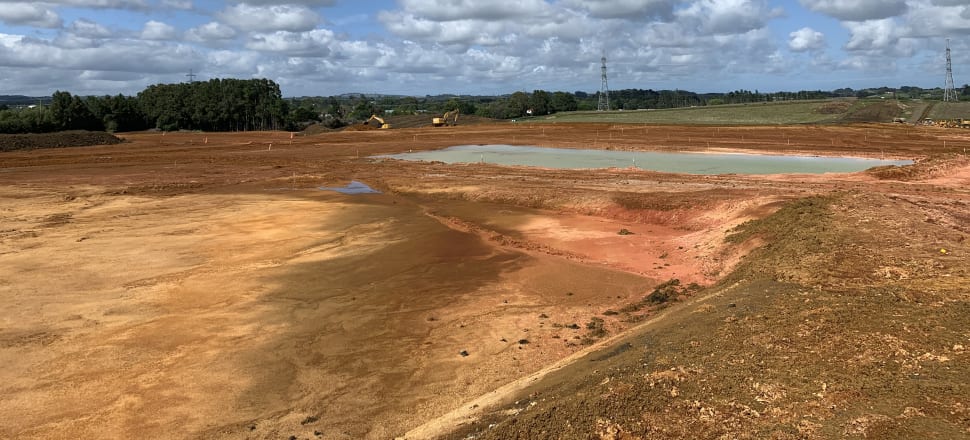
Funding massive growth is a tall order for a cash-strapped council, but developers warn hefty contributions push up house prices
Earthworks have begun at Kiwi Property’s 51ha Drury Town Centre project, a green star community that will include houses, retail, open spaces and public assets such as a town hall and libraries.
The town centre is the first step in a wider development for the area which will see 60,000 people moving in over two decades, requiring millions in infrastructure spend from Auckland Council.
The council is currently proposing that developers pay for infrastructure in the Drury-Ōpaheke area through a policy that would see them contribute in excess of $80,000 on average per household.
Elsewhere in Auckland is up from $22,564 per household.
The development policy for the growth area on Auckland’s southern border also includes contributions for infrastructure for the next 30 years while the standard policy only looks forward 10 years.
Kiwi Property and other major developers in the area, including Oyster Capital and Fulton Hogan, submitted against the council’s proposal.
Submissions were released in December.
READ MORE: * Court approves high-cost, high-rise Drury town centre after council appeal * Hash out intensification funding or risk under-servicing communities * Housing intensification is upending our lives in ways we never imagined
Kiwi Property’s submission took issue with a lack of transparency around calculations behind the proposal, the inclusion of the future infrastructure costs and its social/housing affordability implications.
It said the extra cost would have to be passed on to incoming residents in the form of higher rents as well as incentivising less affordable and larger, more profitable homes to retain profit margins.
The submission went on to say by applying additional costs in the area but not elsewhere in Auckland it favoured development in established wealthy suburbs and imposed greater costs on areas where purchasers were less likely to have the capacity to fund contributions.
Kiwi Property’s Drury development director David Schwartfeger said the company’s Drury Town centre development was providing all of its own infrastructure. “We want Drury to be treated equally, so if we're providing for the infrastructure ourselves, why would you charge Drury substantially more than what you charge other people in other parts of the city?”
Once the works are complete the relevant infrastructure will be handed over to council.
“In theory Drury should be a growth area. It's one of the priority projects for central government, why would you charge them something substantially different than other areas?”
Central government has put billions into infrastructure in the area including the motorway expansion, rail electrification and a new railway station (adjacent to the Drury town centre).
House prices
While Kiwi Property’s submission mentioned it, Schwartfeger said it was difficult to say exactly how housing supply and pricing would be impacted without a final policy to work from.
Auckland Council itself said independent economic advice found there was no evidence it would lead to higher house prices.
A Market Economics report into the development contributions policy, commissioned by Ryman Healthcare, took issue with the council’s stance on affordability.
Report author Greg Akehurst said the advice given to council was that the additional fees would lower the price developers can bid for raw land to develop.
Akehurst said the fact that almost all land to be developed for residential purposes in the area had already been purchased meant that land prices would not fall, and the effect of significantly higher development charges would most likely cause prices to increase.
Kiwi Property chief executive Clive Mackenzie called for a balance to be found for all new development across Auckland as not to disincentivise intensification in Drury.
Referencing the recent Auckland floods, Mackenzie said it was clear infrastructure needed to be updated in the central city for intensification to occur.
“There needs to be a level playing field across the whole of the Auckland greater metropolitan area in terms of development contributions.
“It's probably more expensive to put in a lot of infrastructure in the city or in an existing location than it is in a greenfield location, there’s a balance that needs to be found.”
Auckland Council is currently in the process of figuring out how exactly it will fund infrastructure costs created by the intensive/permissive development mandated by central government.
The changes require councils to enable the development of buildings six stories or more within walking distance of the city and other metropolitan centres, as well as rapid transit stops, and three-storey housing around much of the residential city.
This growth will require infrastructure to support the increased population, including public transport, roading, retail, workplaces, healthcare, schools and water.
It has a handful of tools available to make this happen but has called for a reform of the system for local government to finance and fund infrastructure.







